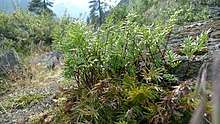Aspidotis densa
Aspidotis densa is a species of fern known by the common name Indian's dream. It is native to western North America from British Columbia to California to Wyoming, as well as parts of eastern North America including Quebec.
| Aspidotis densa | |
|---|---|
| Scientific classification | |
| Kingdom: | Plantae |
| Clade: | Tracheophytes |
| Class: | Polypodiopsida |
| Order: | Polypodiales |
| Family: | Pteridaceae |
| Genus: | Aspidotis |
| Species: | A. densa |
| Binomial name | |
| Aspidotis densa (Brack.) Lellinger, 1968 | |
| Synonyms | |
|
Cheilanthes siliquosa | |
A. densa grows in rocky areas; in California it is often a member of the serpentine soils flora on rocky mountain slopes, well-drained but seasonally moist.
This fern has leaves on long petioles, with the blade occupying less than half of the total length of the leaf when including the petiole. The fertile and sterile leaves may look alike or slightly different. The leaf blade is triangular and composed of many leaflets which are subdivided into untoothed segments. The segments are lined with sori over which the edges of the leaf are folded to form a false indusium.
Aspidotis densa develops on crevices and exposed rocky outcrops in mossy cracks, and over time creeps to fill in every fissure, creating well-established colonies in the outcrop. They may exhibit frond dimorphism, that is, the sterile fronds are shorter and pinnae broader than the fertile, which rise above on long, wiry petioles. The pinnae of the fertile fronds are very narrow and lace-like [4].
Height: 2-4 in. Width 6-12 in.
As ecologic indicator
Aspidotis densa is a regional ecologic indicator on areas where ultramafic rocks are patchy, such as the Klamath Mountains of northern California and southwest Oregon, the areas of serpentine soil can be clearly seen as sparsely covered areas or open forest bounded by closed forest on the non-ultramafic soils [1].

Phylogeny
Relationships between vascular plants with an emphasis on the ferns as summarized from morphological and molecular phylogenetic analyses. Kenrick and Crane (1997) summarizes the results of previously published studies[2].
For a complete fern family phylogeny see Smith et al. (2006) [3].
References
- Alexander, Earl B., Roger G. Coleman, Todd Keller-Wolf, and Susan P. Harrison. Serpentine Geoecology of Western North America. Oxford New York: Oxford University Press, 2007. Print
- Kenrick, P., and Crane, P. R. (1997). The Origin and Early Diversification of Land Plants: A Cladistic Study. Washington, DC: Smithsonian Institution Press.
- Smith, A. R., Pryer, K. M., Schuettpelz, E., Korall, P., Schneider, H., and Wolf, P. G. (2006). A classification for extant ferns. Taxon 55, 705–731. doi: 10.2307/25065646
- Cullina, William. Native Ferns Moss and Grasses. New York, New York: New England Wild Flower Society, 2008. Print.
- C.Michael Hogan, ed. 2010. ‘’Aspidotis densa’’ . Encyclopedia of Life.
- Jepson Manual Treatment
External links
- USDA Plants Profile for Aspidotis densa (Indian's dream)
- Calflora Database: Aspidotis densa (Cliffbrake, Indian's dream)
- Jepson Manual eFlora (TJM2) treatment of Aspidotis densa
- Hardy Fern Library
- Flora of North America
- UC Photos gallery — Aspidotis densa
| Wikimedia Commons has media related to Aspidotis densa. |